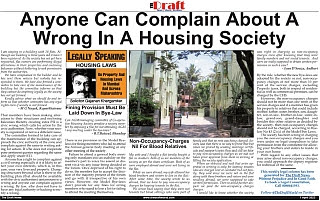Issue Of Hawkers
Rashmi Singhvi | Mumbai
With regard to the hawker situation in Mumbai, in March 2018, only 23,265 hawkers were found eligible for licensing in Mumbai. And these were from a total of 96,655 applications that arrived for regularisation. In all, an estimated two lakh hawkers operate on Mumbai's roads, adding to the traffic mess so typical of Mumbai. BEST buses simply cannot move in zones that are peppered with obstinate hawkers. South Central Mumbai that comprises zones such as Dadar, Lalbaug and Parel even in the suburbs such Andheri, Ghatkopar, Malad and Kandivali's interior roads are choc-a-block with hawkers, mostly illegal yet a sizeable portion enjoy local political patronage or simply pay regular haftas thereby persisting with their activities, albeit illicit, with impudence.
It may be recalled that it was the Elphinstone Road Station stampede in 2017 that led to 23 people BEING killed and 59 others injured. Then, opposition parties and the Shiv Sena, an ally of the ruling Bharatiya Janta Party (BJP) in the state demanded illegal hawkers be removed from stations to ease commuters’ movement. Maharashtra Navnirman Sena's workers even roughed up illegal hawkers on bridges for a while before they returned, as usual.
Then, the Removal of Encroachment Department of BMC had demarcated a line outside the station to ensure hawkers adhere to the High Court order of not setting up a kiosk within 150 metre radius of the station. That apart, it has been was observed that hawkers almost always returned to their original spots within a few months of eviction. Hawkers, on their part, allege they were not allotted any space despite being eligible for it.
This report has been prepared for DraftCraft International’s flagship initiative The Public Space Project in conjunction with its pilot endeavours - The Right To Walk Project, The Gateway of India Project and The Elephanta Island Project to research, analyse and determine the rights of the common man, the pedestrian, the tourist and the rights of the masses availing public transportation in contrast to those privileged few owning private vehicles. The initiative examines laws and policies regarding transport, access to public spaces and privacy guaranteed to all by the State in context of the Right To Equality, Freedoms and the Right to Life.
With regard to the hawker situation in Mumbai, in March 2018, only 23,265 hawkers were found eligible for licensing in Mumbai. And these were from a total of 96,655 applications that arrived for regularisation. In all, an estimated two lakh hawkers operate on Mumbai's roads, adding to the traffic mess so typical of Mumbai. BEST buses simply cannot move in zones that are peppered with obstinate hawkers. South Central Mumbai that comprises zones such as Dadar, Lalbaug and Parel even in the suburbs such Andheri, Ghatkopar, Malad and Kandivali's interior roads are choc-a-block with hawkers, mostly illegal yet a sizeable portion enjoy local political patronage or simply pay regular haftas thereby persisting with their activities, albeit illicit, with impudence.
 |
| In March 2018, only 23,265 hawkers were found eligible for licensing in Mumbai |
It may be recalled that it was the Elphinstone Road Station stampede in 2017 that led to 23 people BEING killed and 59 others injured. Then, opposition parties and the Shiv Sena, an ally of the ruling Bharatiya Janta Party (BJP) in the state demanded illegal hawkers be removed from stations to ease commuters’ movement. Maharashtra Navnirman Sena's workers even roughed up illegal hawkers on bridges for a while before they returned, as usual.
Then, the Removal of Encroachment Department of BMC had demarcated a line outside the station to ensure hawkers adhere to the High Court order of not setting up a kiosk within 150 metre radius of the station. That apart, it has been was observed that hawkers almost always returned to their original spots within a few months of eviction. Hawkers, on their part, allege they were not allotted any space despite being eligible for it.
This report has been prepared for DraftCraft International’s flagship initiative The Public Space Project in conjunction with its pilot endeavours - The Right To Walk Project, The Gateway of India Project and The Elephanta Island Project to research, analyse and determine the rights of the common man, the pedestrian, the tourist and the rights of the masses availing public transportation in contrast to those privileged few owning private vehicles. The initiative examines laws and policies regarding transport, access to public spaces and privacy guaranteed to all by the State in context of the Right To Equality, Freedoms and the Right to Life.



